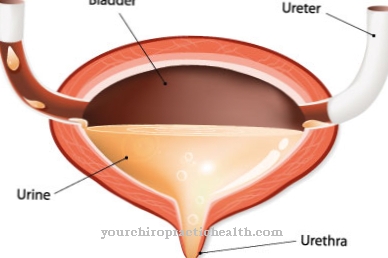The spinal muscular atrophy (SMA) is a group of diseases that are characterized by muscle wasting. The SMA is caused by the destruction of the motor nerve cells in the spinal cord.
What is spinal muscular atrophy?

© Artemida-psy - stock.adobe.com
The concept of progressive spinal muscular atrophy was coined by the neurologist John Hoffmann in Heidelberg in 1893. The spinal muscular atrophies are diseases that are based on a decline of the alpha motor neurons. Alpha motor neurons are nerve cells in the central nervous system (CNS).
They are located in the brain stem and anterior horn of the spinal cord and are responsible for the innervation of the skeletal muscle fibers and thus also for muscle contraction. The decline in motor neurons in SMA is progressive. Due to the loss, the impulses from the nervous system can no longer be passed on to the muscles. The result is paralysis with muscle wasting and decreased muscle tension.
causes
Spinal muscular atrophy is a hereditary disease. Like most neuromuscular diseases, spinal muscular atrophy is rare. The most common form is the infantile form. Here one child falls ill for every 25,000 births. In the juvenile form, only one child is affected in every 75,000 births. The acute infantile form of SMA even begins in the womb before birth. In the juvenile form, the symptoms only begin in childhood or adolescence.
Symptoms, ailments & signs
The loss of motor nerve cells leads to muscle wasting and muscle weakness. Usually the muscles contract when activated by the supplying nerves. The muscle contracts, it gets shorter and tenses. The intended movement can thus be carried out. Muscles that are no longer innervated due to the SMA can no longer contract either.
So the muscle can no longer be used. Due to the immobilization, he becomes more and more slender. If a large number of muscle fibers are affected by the paralysis, a decrease in substance of the entire muscle can be observed. In contrast to muscular dystrophy, the muscle itself is not affected here. This is why this muscle wasting is also known as muscle atrophy. As the disease progresses, the strength and endurance of the muscles decrease.
The affected patients can no longer perform certain movements or only for a very short period of time. The muscles tire much faster than in healthy people. The acute infantile form of SMA is already noticeable in the womb. The children move very little in the womb. Reduced muscle tension is evident at birth. Spontaneous movements rarely occur.
The children cannot keep their heads free and cannot sit freely either. The affected children die of breathing difficulties within the first two to three years of life. In the intermediate form, the first symptoms appear in the first months or years of life. The children can no longer walk or stand. Curvature of the spine and deformation of the chest occur. Most patients do not reach the age of 20.
The juvenile form of progressive spinal muscular atrophy begins in late childhood or adolescence. The first muscle weaknesses usually affect the muscles of the pelvic girdle. Clumsy climbing stairs is one of the first symptoms. In the course of time, the muscle weakness also spreads to the rest of the muscles. Occasionally a very strong calf can be observed in the affected patient. This contains more fat and connective tissue.
Adult spinal muscular atrophy begins in adulthood and progresses much more slowly than the other forms of SMA. They often start with weakness and dwindling of the hand muscles. A weakness of the foot muscles can also be the first indication of an adult SMA.
When the disease affects the cranial nerves, there is also difficulty swallowing, chewing, or speaking. If the cranial nerves are involved, it is usually Kennedy type spinobulbar muscle atrophy (SBMA) or progressive bulbar paralysis.
Diagnosis & course of disease
When making the diagnosis, the patient's detailed medical history and description of the functional disorder are taken into account. This is followed by a detailed physical and neurological examination. This includes procedures such as electroneurography or electromyography. In electroneurography, the nerve conduction velocity is measured. In electromyography, muscle currents are measured.
With the help of both procedures, spinal muscular atrophy can be differentiated from multifocal motor neuropathy. In addition, procedures such as needle electromyography, motor electroneurography or sensitive electroneurography can be performed.
In the laboratory, parameters such as the rate of sedimentation, creatine kinase, vitamin B12, vitamin D, thyroid hormones or parathyroid hormone are determined. An examination of the nerve water can also provide information. X-rays of the cervical spine or slices of the brain and cervical spine may also have to be made. The muscle biopsy or the nerve biopsy provide further information.
Complications
Primarily those affected with this disease suffer from severe muscle weakness and muscle wasting. This results in significant restrictions in everyday life and thus complications. Ordinary activities are no longer easily possible for the person concerned, so that in many cases the patients are dependent on the help of other people.
Many of those affected also suffer from psychological complaints or depression and need psychological treatment. As a rule, this disease does not heal itself and the patient's muscle strength continues to decrease as a result of the disease. Breathing is also significantly weakened, so that those affected suffer from breathing difficulties and thus possibly from dizziness or from a loss of consciousness.
Furthermore, there is a curvature of the spine and severe deformations in the back. These also have a very negative effect on the patient's quality of life. In most cases, the person's life expectancy is limited to 20 years. Since a causal treatment of the disease is not possible, only the symptoms can be limited. There are no particular complications. However, this disease does not lead to a completely positive course of the disease.
When should you go to the doctor?
In any case, direct treatment by a doctor is necessary for this disease. As a rule, self-healing cannot occur, so that the patient is always dependent on an early examination and treatment.
The earlier the disease is recognized and treated, the better the further course of the disease will usually be. A doctor should be consulted if the person concerned has very severe muscle weakness. In most cases, the patient can no longer perform heavy activities and often feels tired and exhausted. In addition, weak breathing can often indicate the muscle atrophy and should also be examined by a doctor. Some people also suffer from curvature of the spine and a deformed chest. If these symptoms occur, a doctor must be consulted.
Usually the muscular atrophy can be detected by a general practitioner. There are no particular complications in the treatment.Life expectancy is also not changed by this disease. However, it cannot be universally predicted whether a full cure is possible.
Therapy & Treatment
The aim of therapy for SMA is to improve muscle function. The affected patients should remain independent and self-sufficient for as long as possible. Treatment is usually given by a team of doctors, physiotherapists, speech therapists, occupational therapists and social workers.
Physiotherapy, occupational therapy and speech therapy are carried out on an outpatient basis and serve to maintain the skills that are still available. The course of the disease can be positively influenced by inpatient rehabilitation measures. Since the main cause of clinical problems is muscle weakness, targeted training of the muscles can be helpful. In individual cases, orthotics can improve functionality.
According to scientists at the Freiburg University Clinic, children with spinal muscular atrophy benefit from an early start of therapy with Nusinersen (Spinraza) in maintaining their motor skills.
You can find your medication here
➔ Medicines for muscle weaknessprevention
Since spinal muscular atrophy is inherited, prevention is not possible.
Aftercare
With spinal muscular atrophy, those affected must carry out special training units to support the muscles as follow-up care. In addition to further medical treatment, those affected can independently perform exercises recommended by the doctor at home. Those affected should urgently avoid overexertion or excessive strain.
Otherwise the disease and symptoms may worsen. In order to be able to cope with the illness in everyday life, those affected need emotional stability. Above all, however, the disease can be overcome with the support and help of family and relatives. Those affected should have an intact social environment so that help can be obtained at any time.
Since the disease cannot be cured, those affected should undergo permanent psychological counseling. In this way, those affected can learn how best to live with the disease. A support group can also be helpful. There those affected can compare the way of life with other sick people and do not feel alone with the disease.
In addition, those affected can learn other methods of how to deal with the disease. In order to improve the quality of life, activities should be chosen that gave them pleasure before the illness. It would be advisable to do this together with people from the familiar social environment.
You can do that yourself
Various studies have shown that the progression of the disease can be delayed if specific training units are carried out to support the muscular system.
In addition to the offered physiotherapy sessions, the person affected can independently perform regular exercises in everyday life to maintain and improve the muscular system. In cooperation with the physiotherapist, individual training sessions are developed that the person concerned can use independently at home and on the go. Avoid situations of overuse or overload. You can revise training successes and contribute to a worsening of the situation.
The disease poses a particular challenge due to the visual changes and abnormalities. In order to cope with the disease in everyday life, emotional stability is therefore particularly important. Self-confidence is to be promoted and an open approach to complaints and their causes are helpful. The progressive course of the disease should be discussed with the patient at an early stage. Only in this way can unpleasant situations be avoided and the person affected can mentally prepare for possible developments in good time.
As it is a hereditary disease, no relief or cure for the disease is expected. The patient must therefore learn to structure his or her lifestyle as optimally as possible with the health restrictions. Contact with other sick people or with self-help groups can be helpful.













.jpg)

.jpg)
.jpg)











.jpg)